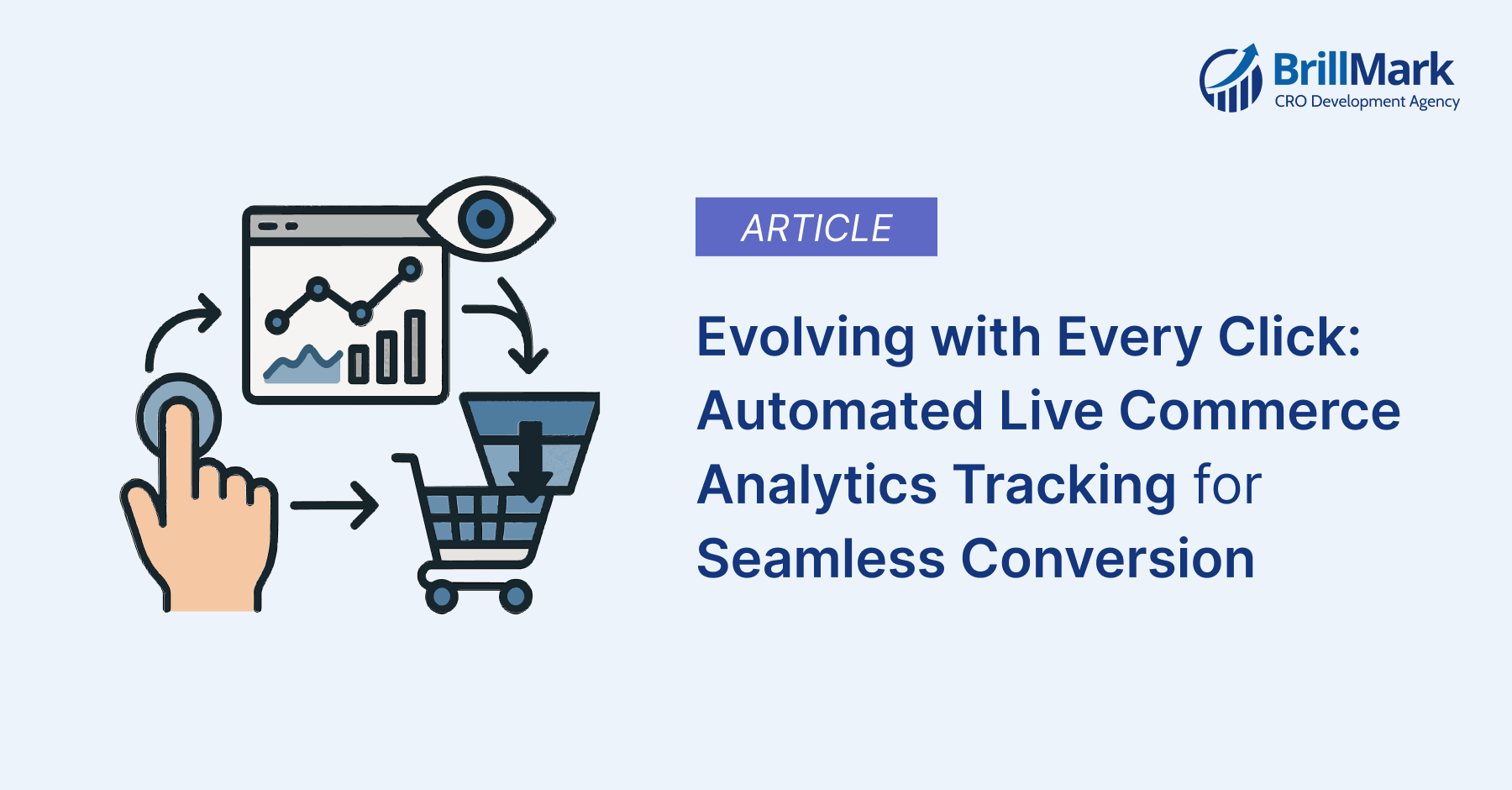The digital shopping landscape is in constant flux, and Live Commerce has emerged as a powerful force, blending entertainment with instant purchasing opportunities. This dynamic format generates significant Live Commerce traffic surges, creating a direct line to engaged consumers. However, the true measure of success in Live Commerce lies not merely in attracting a large audience but in effectively converting those viewers into valuable customers and understanding the nuanced path they take.
To harness the full potential of this traffic and drive Live Commerce conversion rate optimization, businesses need a sophisticated approach. This involves meticulously tracking every user interaction, applying intelligent analysis powered by AI and Machine Learning, and continuously refining the experience through automated experimentation. By implementing automated Live Commerce tracking setups that can adapt to changing viewer behavior and market dynamics, brands can remove obstacles from the customer journey and achieve seamless conversions.
The Foundation: Building a Granular, Automated Tracking Setup
Effective Live Commerce conversion begins with a deep understanding of viewer behavior. A robust, automated tracking infrastructure is paramount. It must go beyond surface-level metrics to capture granular actions within the live stream environment and as viewers transition to other parts of your e-commerce ecosystem. This detailed data is the fuel for AI-powered Live Commerce insights and effective optimization.
Steps for Implementing Automated Tracking:
- Comprehensive Event Definition: Work with marketing, sales, and product teams to define every significant user event. This includes not just standard e-commerce events (product view, add to cart, purchase) but also Live Commerce-specific interactions:
- Joining/Leaving the stream
- Watching duration (total and per segment)
- Chat message frequency and content (can be analyzed for sentiment later)
- Reactions (likes, hearts, emojis)
- Clicks on pinned products, links in chat, or on-screen calls-to-action
- Sharing the stream
- Interactions with polls or Q&A features. Automating the tagging and tracking of these events ensures scalability during traffic peaks.
- Cross-Platform Implementation: Ensure tracking is consistent across all touchpoints: the Live Commerce platform (if external), your website, your mobile app, and any linked social media channels. This requires integrating tracking codes (like Google Analytics 4, Adobe Analytics, or custom event tracking APIs) seamlessly.
- User Identification Strategy: Implement a strategy to identify users across devices and sessions. This may involve logged-in user IDs, cookie tracking, or utilizing a Customer Data Platform (CDP) to consolidate user profiles. This is essential for mapping the complete Live Commerce customer journey.
- Real-Time Data Pipelines: Configure data connectors or APIs to push tracking data into a central data warehouse or analytics platform in near real-time. The speed of data flow is critical for timely analysis and the ability to react during a live event.
- Validation and Maintenance: Regularly audit your tracking setup to ensure accuracy and completeness. Automated alerts can notify you of tracking errors or data discrepancies. As your Live Commerce strategy evolves, your tracking plan must evolve with it.
Why Automated Tracking is Crucial for Traffic Surges: Live Commerce events can generate massive, simultaneous user activity. Manual tracking or delayed data processing simply cannot keep up. An automated setup ensures that every click, reaction, and product interaction from potentially thousands or millions of viewers is captured accurately. This provides the rich dataset needed to understand the behavior of the Live Commerce audience and identify specific points of friction in their path to purchase. Studies on optimizing e-commerce logistics underscore the importance of efficient data flow and process management, principles directly applicable to managing and understanding Live Commerce traffic (PostNord, Infosys BPM).
The Intelligence: AI-Powered Analysis to Uncover Insights
Collecting vast amounts of tracking data is only the first step. The real magic happens when Artificial Intelligence and Machine Learning are applied to analyze this data. AI can uncover hidden patterns, segment audiences based on subtle behaviors, predict future actions, and pinpoint the exact moments and reasons viewers fail to convert. This provides the AI-powered Live Commerce insights needed to inform optimization efforts.
How AI Transforms Tracking Data into Actionable Insights:
- Granular Audience Segmentation: Beyond basic demographics, AI can segment viewers based on their real-time engagement levels (e.g., “highly engaged chat participants interested in product X,” “viewers who watched the demo of product Y but left before the call-to-action”). This level of detail enables highly targeted follow-up and personalization, a core benefit of AI in e-commerce (vertixai).
- Behavioral Flow Mapping: AI algorithms can analyze the sequence of events for different user segments, identifying common successful paths to conversion and, more importantly, common paths that lead to drop-off. This helps visualize the Live Commerce conversion funnel and where obstacles exist.
- Obstacle Identification and Prioritization: By correlating in-stream behavior (such as repeated questions in chat or rapid navigation away from a product page) with drop-off rates, AI can automatically flag potential points of friction. For example, AI might detect that viewers who click on a specific product during the stream are leaving the product page within seconds if a key piece of information (like a size chart or compatibility detail) is not immediately visible.
- Predictive Conversion Scoring: AI models can assign a conversion probability score to individual viewers based on their real-time and historical behavior. This allows hosts or automated systems to prioritize engaging with high-potential viewers. AI/ML are already widely used for predictive analytics and personalized offers in retail (Exchange Solutions, Appinventiv, TechNative, Itransition).
- Content Performance Correlation: AI can analyze which products, demonstrations, host interactions, or offers within the live stream correlate most strongly with positive engagement and conversion events for different segments.
Example: AI analyzing the tracking data from a live stream featuring apparel might identify that viewers who commented on the fit of a garment in the chat are highly engaged but have a low conversion rate if they navigate to a product page lacking detailed sizing information or a virtual try-on feature. This insight points directly to a significant obstacle in their conversion journey.
The Experimentation Lab: Automated A/B Testing for Continuous Optimization
Insights from AI provide hypotheses about how to improve the Live Commerce conversion funnel. Automated A/B testing is the mechanism to scientifically validate these hypotheses and implement the most effective solutions at scale. Automation is crucial here for speed and efficiency, allowing for rapid iteration, especially given the fast-paced nature of Live Commerce.
Leveraging Automated A/B Testing for Live Commerce:
- Hypothesis Generation (AI-Informed): Based on AI-identified obstacles or opportunities, formulate clear, testable hypotheses (e.g., “Adding a ‘View Size Chart’ button directly on the live stream product overlay will increase the add-to-cart rate for apparel items”).
- Automated Variation Creation: Use A/B testing tools integrated with your Live Commerce and e-commerce platforms to create variations of the element you want to test (e.g., Variation A: original product overlay; Variation B: product overlay with the new button).
- Targeted Experimentation: Deploy the A/B test to specific audience segments identified by AI (e.g., only show the variation to viewers who are engaging with apparel products). This ensures relevant results.
- Automated Measurement & Analysis: The A/B testing framework automatically tracks the performance of each variation using the granular event data from your tracking setup. It measures key metrics (clicks on the new button, time on product page, add-to-cart rate, conversion rate) and uses statistical analysis to determine which variation is the winner.
- Automated Winning Variation Deployment: Once a variation is statistically proven to be better, the automated system can automatically roll out the winning version to all relevant viewers, optimizing the experience in near real-time or for subsequent streams.
Example: Following the AI insight about sizing information, an automated A/B test is set up. Viewers clicking on apparel products from the live stream are randomly shown either the original product overlay or the new one with the size chart button. The tracking system records interactions. Suppose the variation with the button leads to a statistically significant increase in conversions for that segment. In that case, the automated system makes this the default product overlay for apparel in future streams. This iterative testing and refinement process is key to increasing Live Commerce sales and aligns with best practices in e-commerce conversion (Hitachi Solutions).
The Outcome: Continuous Evolution and Seamless Conversion
The synergy of automated tracking, AI-powered Live Commerce insights, and automated A/B testing creates a dynamic system that allows the Live Commerce experience to evolve with every click. This continuous feedback loop drives significant improvements:
- Enhanced Audience Experience: By identifying and removing obstacles, personalizing interactions based on AI insights, and validating improvements through A/B testing, the Live Commerce experience becomes more intuitive, engaging, and tailored to individual viewer needs. This fosters a sense of seamlessness that encourages viewers to stay engaged and explore products.
- Maximized Conversion Rates: The direct result of removing friction and optimizing the user journey is a higher percentage of viewers completing a purchase. Automated systems ensure that the most effective pathways to conversion are automatically implemented.
- Accurate Performance Measurement: The detailed tracking setup provides the data needed for accurate Live Commerce performance tracking and measuring Live Commerce ROI. You can clearly see which aspects of your Live Commerce strategy are driving results.
- Competitive Edge: This data-driven, automated approach allows businesses to adapt quickly to changing viewer behavior and market trends, staying ahead of competitors who rely on manual analysis and slower implementation cycles. The ability to rapidly test and deploy optimizations is a significant advantage in the fast-paced world of Live Video Shopping.
Creating a Frictionless Path: Imagine a viewer who joins a live stream, sees a product demonstrated, clicks on it, is taken to a product page optimized based on previous A/B tests (perhaps featuring a prominent video clip from the stream or AI-recommended complementary products), easily finds the information they need (because AI identified where others got stuck), adds the item to their cart, and proceeds through a streamlined checkout process that remembers their details and offers flexible payment options like BNPL (which has been shown to boost conversion rates – Telefonica, Ecommpay). Every step of this frictionless Live Commerce checkout is a result of the integrated tracking, AI analysis, and automated optimization process.
By implementing AI AI-driven Live Commerce strategy supported by robust automated tracking and A/B testing, businesses can effectively manage the Live Commerce traffic surge, transforming it into a powerful engine for e-commerce conversion and sustainable growth. The ability to evolve with every click ensures the experience remains relevant, engaging, and highly effective at turning viewers into valuable buyers.
META DESCRIPTION
Optimize Live Commerce conversions with automated tracking, AI insights, and A/B testing for a seamless customer journey.











